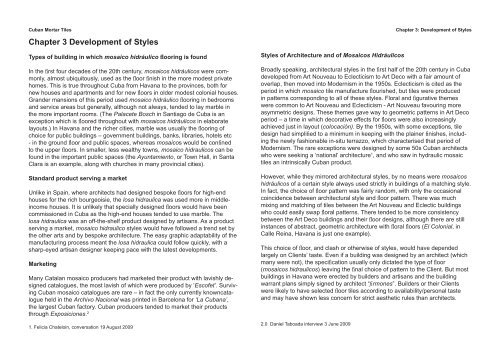Cuban Mortar Tiles - infogram.co.uk > Home
Cuban Mortar Tiles - infogram.co.uk > Home
Cuban Mortar Tiles - infogram.co.uk > Home
You also want an ePaper? Increase the reach of your titles
YUMPU automatically turns print PDFs into web optimized ePapers that Google loves.
<strong>Cuban</strong> <strong>Mortar</strong> <strong>Tiles</strong> Chapter 3: Development of Styles<br />
Chapter 3 Development of Styles<br />
Types of building in which mosai<strong>co</strong> hidráuli<strong>co</strong> fl ooring is found<br />
In the fi rst four decades of the 20th century, mosai<strong>co</strong>s hidráuli<strong>co</strong>s were <strong>co</strong>mmonly,<br />
almost ubiquitously, used as the fl oor fi nish in the more modest private<br />
homes. This is true throughout Cuba from Havana to the provinces, both for<br />
new houses and apartments and for new fl oors in older modest <strong>co</strong>lonial houses.<br />
Grander mansions of this period used mosai<strong>co</strong> hidráuli<strong>co</strong> fl ooring in bedrooms<br />
and service areas but generally, although not always, tended to lay marble in<br />
the more important rooms. (The Palacete Bosch in Santiago de Cuba is an<br />
exception which is fl oored throughout with mosai<strong>co</strong>s hidráuli<strong>co</strong>s in elaborate<br />
layouts.) In Havana and the richer cities, marble was usually the fl ooring of<br />
choice for public buildings – government buildings, banks, libraries, hotels etc<br />
- in the ground fl oor and public spaces, whereas mosai<strong>co</strong>s would be <strong>co</strong>nfi ned<br />
to the upper fl oors. In smaller, less wealthy towns, mosai<strong>co</strong> hidrauli<strong>co</strong>s can be<br />
found in the important public spaces (the Ayuntamiento, or Town Hall, in Santa<br />
Clara is an example, along with churches in many provincial cities).<br />
Standard product serving a market<br />
Unlike in Spain, where architects had designed bespoke fl oors for high-end<br />
houses for the rich bourgeoisie, the losa hidraulica was used more in middlein<strong>co</strong>me<br />
houses. It is unlikely that specially designed fl oors would have been<br />
<strong>co</strong>mmissioned in Cuba as the high-end houses tended to use marble. The<br />
losa hidraulica was an off-the-shelf product designed by artisans. As a product<br />
serving a market, mosai<strong>co</strong> hidrauli<strong>co</strong> styles would have followed a trend set by<br />
the other arts and by bespoke architecture. The easy graphic adaptability of the<br />
manufacturing process meant the losa hidraulica <strong>co</strong>uld follow quickly, with a<br />
sharp-eyed artisan designer keeping pace with the latest developments.<br />
Marketing<br />
Many Catalan mosai<strong>co</strong> producers had marketed their product with lavishly designed<br />
catalogues, the most lavish of which were produced by ‘Es<strong>co</strong>fet’. Surviving<br />
<strong>Cuban</strong> mosai<strong>co</strong> catalogues are rare – in fact the only currently knowncatalogue<br />
held in the Archivo Nacional was printed in Barcelona for ‘La <strong>Cuban</strong>a’,<br />
the largest <strong>Cuban</strong> factory. <strong>Cuban</strong> producers tended to market their products<br />
through Exposiciones. 2<br />
1. Felicia Chateloin, <strong>co</strong>nversation 19 August 2009<br />
Styles of Architecture and of Mosai<strong>co</strong>s Hidráuli<strong>co</strong>s<br />
Broadly speaking, architectural styles in the fi rst half of the 20th century in Cuba<br />
developed from Art Nouveau to Eclecticism to Art De<strong>co</strong> with a fair amount of<br />
overlap, then moved into Modernism in the 1950s. Eclecticism is cited as the<br />
period in which mosai<strong>co</strong> tile manufacture fl ourished, but tiles were produced<br />
in patterns <strong>co</strong>rresponding to all of these styles. Floral and fi gurative themes<br />
were <strong>co</strong>mmon to Art Nouveau and Eclecticism - Art Nouveau favouring more<br />
asymmetric designs. These themes gave way to geometric patterns in Art De<strong>co</strong><br />
period – a time in which de<strong>co</strong>rative effects for fl oors were also increasingly<br />
achieved just in layout (<strong>co</strong>locación). By the 1950s, with some exceptions, tile<br />
design had simplifi ed to a minimum in keeping with the plainer fi nishes, including<br />
the newly fashionable in-situ terrazzo, which characterised that period of<br />
Modernism. The rare exceptions were designed by some 50s <strong>Cuban</strong> architects<br />
who were seeking a ‘national’ architecture 1 , and who saw in hydraulic mosaic<br />
tiles an intrinsically <strong>Cuban</strong> product.<br />
However, while they mirrored architectural styles, by no means were mosai<strong>co</strong>s<br />
hidráuli<strong>co</strong>s of a certain style always used strictly in buildings of a matching style.<br />
In fact, the choice of fl oor pattern was fairly random, with only the occasional<br />
<strong>co</strong>incidence between architectural style and fl oor pattern. There was much<br />
mixing and matching of tiles between the Art Nouveau and Eclectic buildings<br />
who <strong>co</strong>uld easily swap fl oral patterns. There tended to be more <strong>co</strong>nsistency<br />
between the Art De<strong>co</strong> buildings and their fl oor designs, although there are still<br />
instances of abstract, geometric architecture with fl oral fl oors (El Colonial, in<br />
Calle Reina, Havana is just one example).<br />
This choice of fl oor, and clash or otherwise of styles, would have depended<br />
largely on Clients’ taste. Even if a building was designed by an architect (which<br />
many were not), the specifi cation usually only dictated the type of fl oor<br />
(mosai<strong>co</strong>s hidrauli<strong>co</strong>s) leaving the fi nal choice of pattern to the Client. But most<br />
buildings in Havana were erected by builders and artisans and the building<br />
warrant plans simply signed by architect “fi rmones”. Builders or their Clients<br />
were likely to have selected fl oor tiles ac<strong>co</strong>rding to availability/personal taste<br />
and may have shown less <strong>co</strong>ncern for strict aesthetic rules than architects.<br />
2.0 Daniel Taboada interview 3 June 2009



